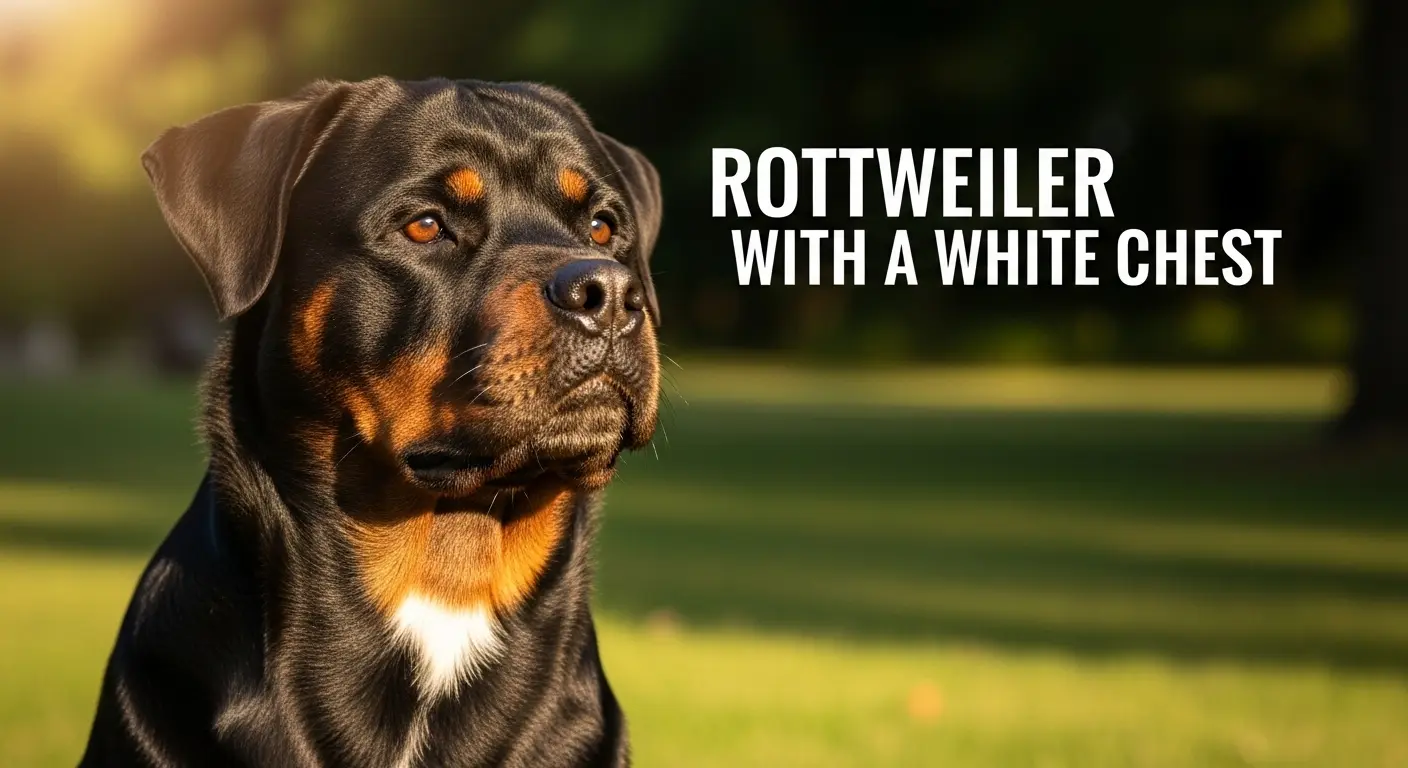You’ve probably seen a few Rottweilers in your life — that sleek black coat, those confident eyes, and that solid, muscular build that basically screams “don’t mess with me.”
But then one day, you spot a Rottweiler with a white chest, and you’re like… wait, is that normal?
Let’s clear this up once and for all. Whether it’s a tiny white patch, a streak across the chest, or even white paws, these markings aren’t as rare or mysterious as people think.
And no, it doesn’t mean your Rottie isn’t purebred. So grab a coffee (or a treat for your pup) — let’s talk about what’s really going on here.
Is a White Chest on a Rottweiler Normal?

Short answer? Yes — totally normal.
The classic Rottweiler look, according to the American Kennel Club (AKC), is a black coat with clearly defined tan markings on the cheeks, chest, and legs. But guess what? Genetics doesn’t always follow the rulebook.
Some Rottweilers are born with small white markings on their chest or paws. These little spots come from leftover pigmentation genes that were common in their distant ancestors.
Back when Rottweilers were still developing as a breed, crossbreeding with other working dogs sometimes carried forward genes that can pop up as white patches even today.
So, if your dog has a white patch on the chest, that doesn’t automatically mean there’s a “mix” in the bloodline. It’s just nature doing its thing.
The Science Behind Those White Markings
Okay, time for a mini science class (I promise it won’t hurt).
A dog’s coat color depends on two main pigments:
- Eumelanin, which creates black or dark brown colors.
- Phaeomelanin, which makes tan, red, or yellow shades.
When certain genes affect how these pigments spread across the coat, you get variations — like that white chest or white paws on your Rottweiler. Basically, those areas didn’t get enough pigment during development.
It’s kind of like when you’re painting a wall and run out of paint halfway through — not a big deal, just a patch where color didn’t fully cover. That’s your Rottie’s chest.
Some breeders even note that small white patches have existed in Rottweiler lines for generations. So instead of being a defect, it’s actually a subtle reminder of their genetic diversity. Pretty cool, right?
Does White Mean “Mixed Breed”?

This is probably the first thing every Rottweiler owner with a white-marked pup hears:
“Oh, maybe he’s not purebred.”
Cue the eye roll. 🙄
Here’s the truth: a white chest doesn’t automatically mean a mixed breed. It could, of course — if the markings are very large or the dog’s structure doesn’t match Rottweiler standards. But a small white patch or a few white hairs? Totally fine.
The AKC breed standard only disqualifies dogs with excessive white markings. A small patch? Acceptable. So unless your dog’s chest looks like it’s been dipped in white paint, there’s no reason to worry.
If you really want peace of mind, you can always run a DNA test (Embark or Wisdom Panel are good options). But IMO, if your Rottie walks, acts, and growls like one — you’re good.
Are Rottweilers with White Chests Healthy?
Here’s the part that matters most: no, white markings don’t affect your dog’s health.
A Rottweiler with a white chest is just as strong, loyal, and protective as one with perfect tan markings. The color variation doesn’t mess with their immune system, bone structure, or temperament.
That said, all Rottweilers — white chest or not — are prone to a few breed-specific health issues, such as:
- Hip and elbow dysplasia
- Heart disease (aortic stenosis)
- Joint problems in older age
- Bloat (gastric torsion) — the dreaded one
So yeah, skip stressing about color and focus on regular vet visits, good nutrition, and exercise. White patch or not, your Rottie needs the same love and care. ❤️
Personality Check: Does Color Affect Temperament?
Nope. Color doesn’t touch personality.
A Rottweiler with a white patch doesn’t act any different from one with standard markings. They still carry that signature mix of confidence, loyalty, and protectiveness that makes them one of the best family guardians.
If anything, a Rottie’s temperament depends on:
- How you train and socialize them
- The breeder’s ethics
- Their environment and upbringing
So, spend your energy on building a great relationship, not overanalyzing fur color. Your Rottie doesn’t care if you’ve got freckles — so let’s return the favor.
White Markings and the AKC Breed Standard
Now, if you’re planning to show your Rottweiler in competitions, this part matters.
The AKC describes the ideal Rottweiler as black with rust or mahogany markings in specific areas — eyebrows, cheeks, chest, legs, and under the tail. Any other color? Not preferred.
Here’s what counts as a fault or disqualification:
- Excessive white markings
- Unclear tan spots
- Long or wavy coat
So, yes — a big white chest could lower show scores. But for pet owners (aka 99% of us), that’s no big deal. Your Rottie’s not losing points for personality at home.
Common Myths About White-Chested Rottweilers
Let’s bust a few popular myths, shall we?
Myth #1: “White means albino.”
Nope. Albino dogs lack pigment entirely, meaning pale skin, pink eyes, and extreme light sensitivity. That’s not what’s happening here.
Myth #2: “They’re unhealthy.”
Again, nope. A white patch doesn’t affect health any more than freckles affect you.
Myth #3: “They’re mixed with another breed.”
Not always. A DNA test can confirm it, but small white patches are common in purebreds too.
Myth #4: “They’re more aggressive.”
This one deserves a massive eye roll. Behavior has zero to do with coat color.
Why Some People Actually Prefer Them

Here’s the funny part: many owners love the white-chested look.
It gives their dog a distinctive edge — a “signature look.” That splash of white often becomes part of their charm. Some owners even say it makes their Rottie look more expressive or easier to identify in photos (because let’s face it, all-black dogs can be camera ninjas).
And honestly? It’s a great conversation starter. Take your Rottie with a white chest to the park and just wait — someone will ask about it.
How to Care for a Rottweiler with White Markings
Nothing complicated here. The grooming routine is the same as any Rottweiler, but there are a few small things to keep in mind:
- Keep that white fur clean. It can show dirt more easily than black areas.
- Use a gentle dog shampoo to prevent irritation.
- Brush weekly to remove loose hair and keep the coat shiny.
- Check for sun exposure. If your Rottie spends a lot of time outside, white fur (especially around the chest) can be a bit more sensitive to UV rays.
But honestly, that’s it. There’s no special “white patch treatment plan.” 🙂
Should You Buy or Adopt One?
If you’re considering bringing home a Rottweiler with a white chest or paws, here’s my take: go for it — as long as the breeder is reputable.
Focus on these factors before making a decision:
- Health and temperament first. Never choose based purely on appearance.
- Ask for health certificates. Responsible breeders test for hip dysplasia and heart issues.
- Avoid “rare color” upsells. Some shady breeders market white markings as “special editions” to charge more. Don’t fall for it.
A Rottweiler’s coat color doesn’t make them any better or worse. What matters is how they’re raised — and how much love (and patience) you’ve got.
Quick FAQs
1. Can a purebred Rottweiler have a white chest?
Yes. Many purebred Rottweilers have small white patches. The AKC allows limited white, but excessive markings aren’t standard.
2. Why does my Rottweiler have white fur on the chest?
It’s due to genetics — certain pigment cells simply didn’t fill in that area during development.
3. Will my Rottweiler’s white patch change over time?
Sometimes! Puppies can have small white spots that fade as they grow. In others, it stays for life.
4. Does a white chest mean health issues?
Nope. It’s purely cosmetic and doesn’t impact health or personality.
Final Thoughts
At the end of the day, a Rottweiler with a white chest isn’t an oddity or a mistake — it’s just a small twist in nature’s design. Those patches don’t make them less purebred, less healthy, or less loyal. If anything, they make your dog stand out in a crowd of near-identical Rotties.
So, if your pup rocks that little white badge of uniqueness, wear it with pride. It’s not a flaw — it’s personality in fur form. 😉
And hey, next time someone at the park says, “Hey, I thought Rottweilers were all black?” — just smile and say, “Yeah, but mine likes to accessorize.” 😎
